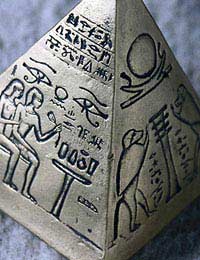
In archaeology the word decipherment is used in reference to the translating of ancient writing into modern texts. One of the unusual realities of archaeological decipherment is that both geniuses and nutters are attracted to it and sometimes it is not easy to tell the two apart.
Simply put, archaeological decipherment is code cracking. Many ancient writings are scripted in symbols that have long lost their dictionary of meanings. The expert in decipherment needs to be a knowledgeable, logical, lateral thinker with a trained linguistic mind. Such a combination of characteristics is often found in the eccentric scholar.
No One to Read the Script
The best-known deciphered scripts are unquestionably Egyptian hieroglyphs. These picture symbols for many years fascinated the world but few, if any, could understand their meaning. Throughout the Far East scholars and archaeologists had been discovering clay tablets with unusual wedge-shaped marks thought to be some form of writing. But again, there was no living person who could unlock the secrets contained in the marks.
Egyptian Hieroglyphs
The Rosetta Stone is an upright, three-sided lithic prism, inscribed with a different language on each of the three faces explaining a royal decree. Members of Napoleon’s army discovered it in 1799 but the British took control of it shortly thereafter. The three languages on it are Demotic, Greek, and Hieroglyph.
Hieroglyphs had been completely superseded shortly after the 4th century AD and for 1,400 years no one had known how to interpret them. However, with the discovery of the Rosetta Stone, decipherment was now possible. Scholars who knew ancient Greek (the old language of business and administration) were able to use the words as a key to unlock the pictures of hieroglyphs. English and French linguists worked on deciphering the stone and were able to show that the pictures represented sounds. Before long ancient Egypt was coming alive through the reading of every hieroglyph.
Unlocking Cuneiform
Many archaeologists and even linguistic scholars did not believe that the markings on the hordes of clay tablets being discovered all over Mesopotamia were indeed writing. The decipherment of the cuneiform script was a much slower process than that of the Rosetta Stone but like the cracking of the Stone the breakthrough came when other inscriptions acted as the key.
Georg Grotefend, a German school teacher, first worked on the interpretation of ancient Persian inscriptions found at Persepolis. He found that two of the most famous Persian kings, that of Darius and Xerxes, had their names and titles within the inscriptions. Yet, it took over fifty years before the code of cuneiform was broken only to find that the solution did not unlock all cuneiform. The reason? There were differing language variants written in the cuneiform script.
Henry Rawlinson, a British army officer discovered more inscriptions carved into rock in Iran. Rawlinson’s cuneiform script contained many more characters than earlier discoveries and some similar ones were used in differing ways. This added a new complication to decipherment.
Thus far, archaeologists have discovered cuneiform script from the Hittite empire, Mesopotamia, Persia and an Ugaritic script from Syria. Scholars are now able to understand nearly every discovered piece of cuneiform and read the myths, legends, business dealings, royal decrees, battles won and lost, and even the mundane inventories of a shoe shop, all providing greater insight into past civilisations.
We Have the Key to Three out of Four
The role of the field archaeologist is the discovery of artefacts and that will always include finding writings in an unknown language. As long as new linguistic material is being excavated then archaeological decipherment is sure to continue. Egyptian, Eastern, and Chinese scripts have all been deciphered. Only one of the classic ‘first four civilisations’ remains a mystery. Whoever opens the door on the Indus Valley script will unlock a wealth of information about the ancient Indian sub-continent.